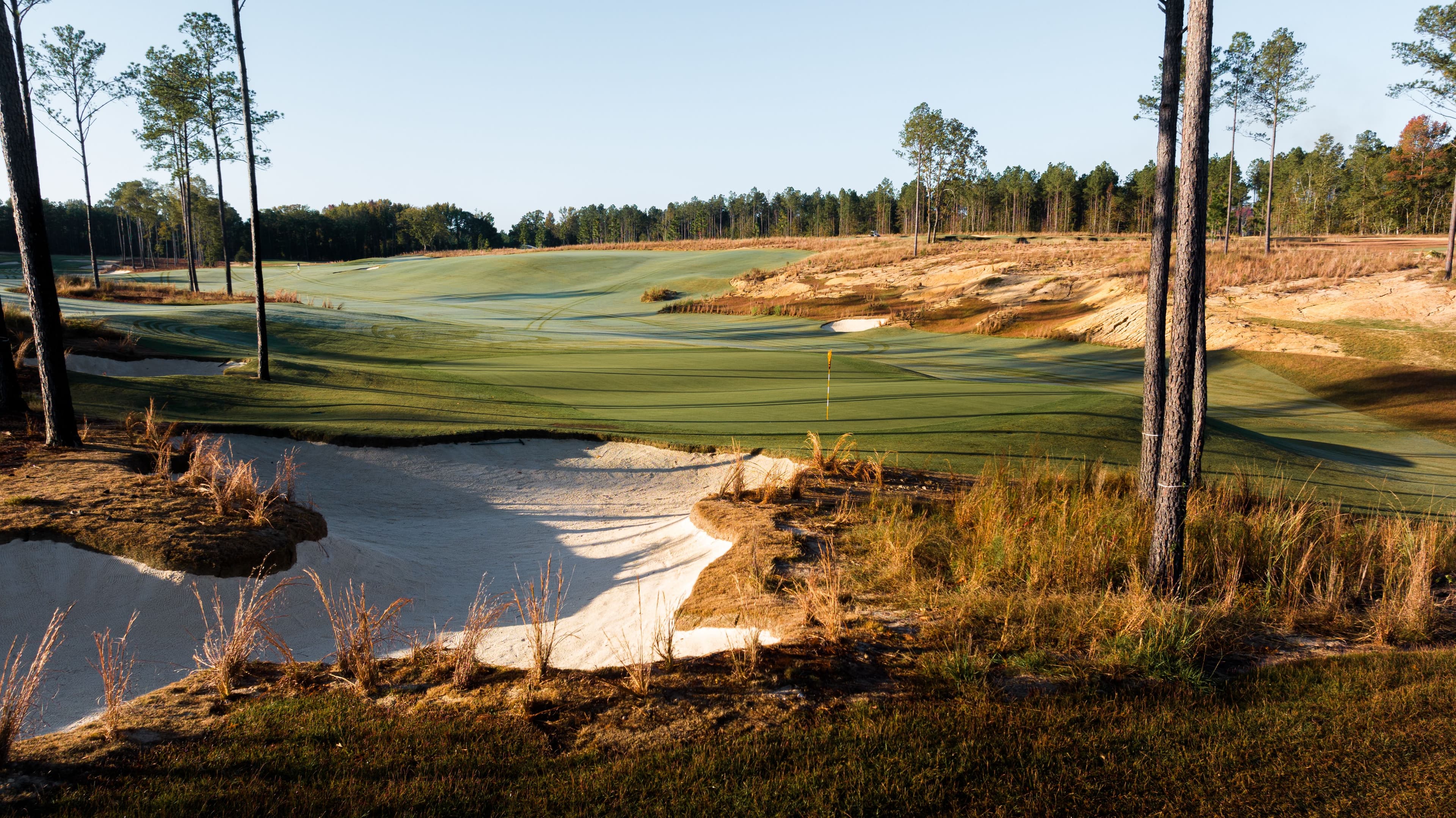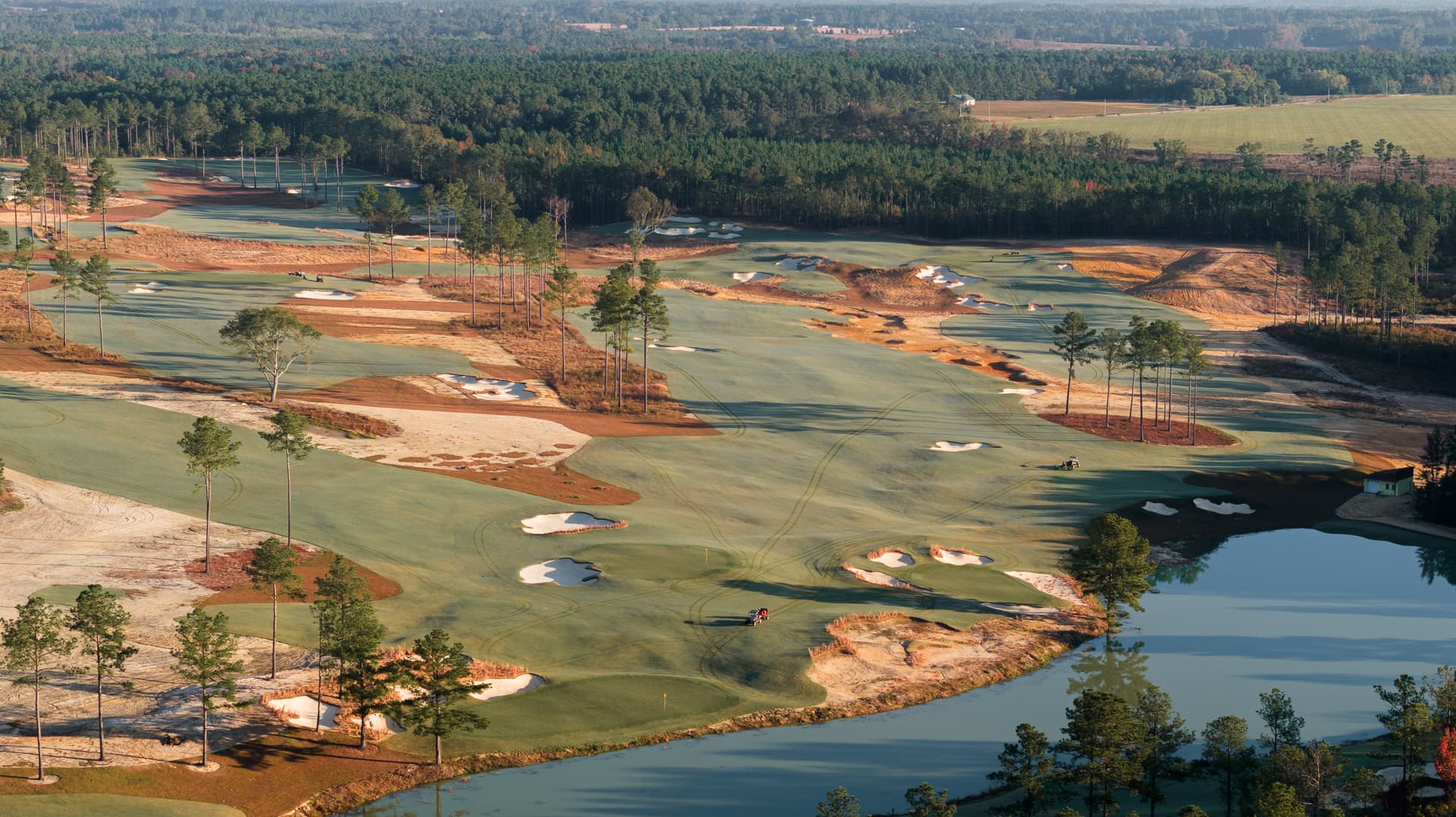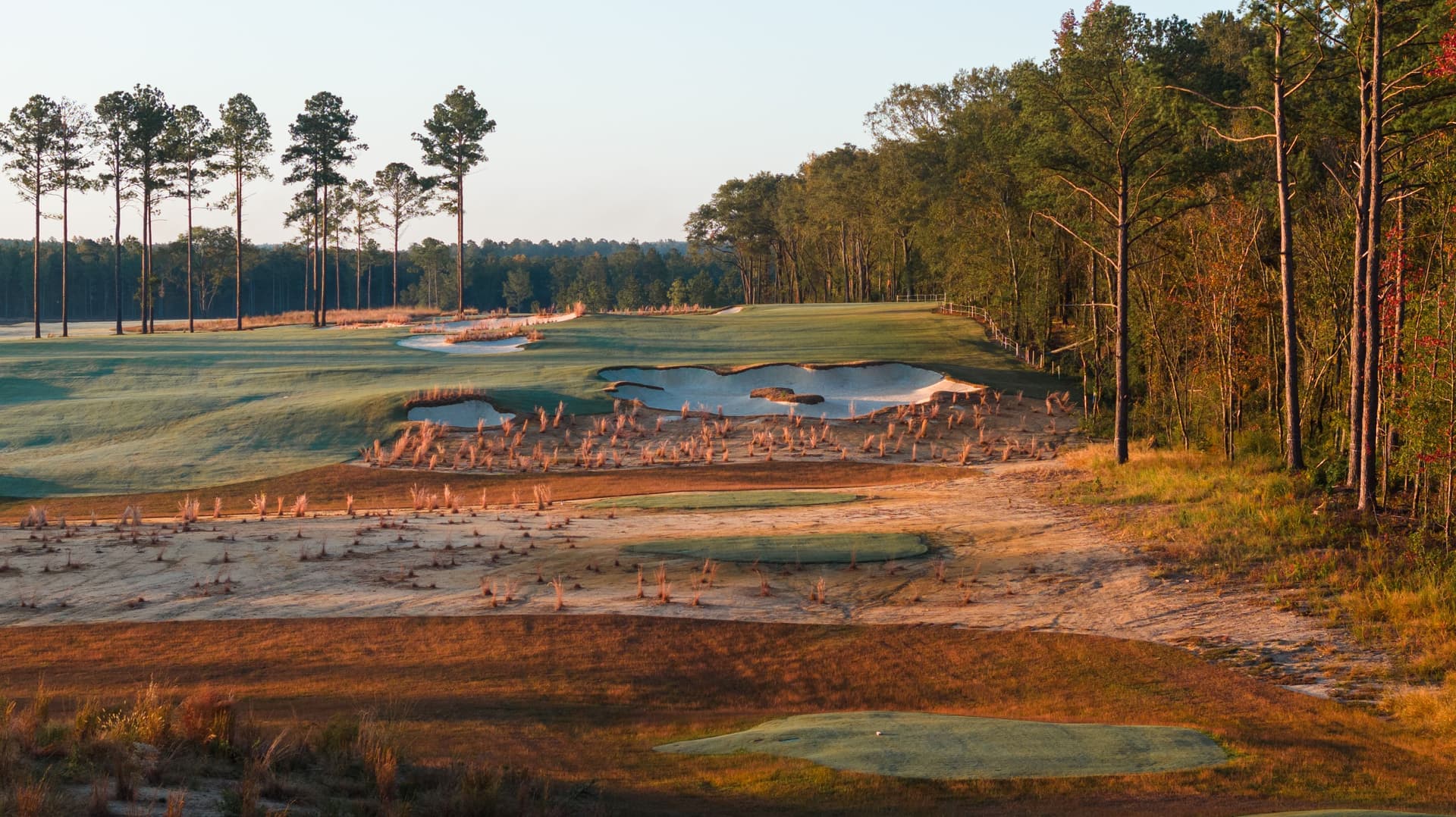
Breaking the Rules at Broomsedge
Every architect knows the informal 'dogmas' of modern golf course design: avoid parallel holes if you can; more land is better; don't put two par 3s in a row; 18 green sites for 18 holes; prioritise visibility and minimise blind shots; avoid out-of-bounds wherever possible; don't make par 3s too long or too short; keep hazards visible; don't put two driveable par 4s close together in the routing; get a slope rating for your scorecard; and countless more. And then there are the conventions of modern golf development – primarily, the common sense proposition of making sure you have the money for course construction, or least a likely pathway to getting it, before you start.
The newly acclaimed Broomsedge Golf Club in Rembert SC apparently never paid attention to any of these. Designed by architects Mike Koprowski and Kyle Franz, Broomsedge proves that great golf doesn't come from the rules – it comes from knowing which ones to break and then breaking them with confidence. Perhaps as much as any other design in the modern era, Broomsedge broke nearly every rule in the book, leading to one of the most varied, surprising, and authentic experiences in all of golf.
Dogma 1: More Land is Better
In an era when modern golf developers pursue thousands of acres of raw land and architects sprawl across it, Mike Koprowski secured a measly 197 acres with an agricultural loan. After subtracting out infrastructure, wetlands, car park, and a driving range, the 7,500 yard golf course would have to sit on just 156 acres – an exceedingly small field for the modern game. 'Scale is cool', said Koprowski. 'But so is intimacy. Sometimes you can build a better golf course on a small footprint than you can on a big footprint. Acreage is not an unequivocal good.'

Photos provided by Broomsedge Golf Club
Photos taken by Andy Johnson - The Fried Egg
Dogma 2: Parallel Holes Are to Be Avoided
Broomsedge opens with four consecutive holes that run parallel with each other in close proximity. 'Usually, avoiding a bunch of parallel holes in sequence is a good rule of thumb', said Kyle Franz. 'But not when you have topography as diverse as Broomsedge.' The first hole traverses gentle up-and-over terrain, not unlike many holes at Pine Needles. The second, which the golfer cannot even see from the first hole despite running parallel to it, falls aggressively sideways into a deep chasm not unlike the 6th at Eastward Ho! The third then navigates a shallower valley and slowly rises to a strange, spiney ridge upon which a long, skinny green sits. And then the fourth hole dangles off the side of a slope with OB smack against the entire right boundary of the hole. 'Nobody would ever believe that this diversity of big, long holes exists in a section of property that is about 500 yards long and 280 yards wide', said David McFarlin, co-founder of Broomsedge.
Dogma 3: Out of Bounds Is to Be Avoided Whenever Possible
In American golf, the dreaded OB is typically utilised to keep golfers out of someone's backyard. But in the UK, OB is often used as a strategic design feature. At Broomsedge, two holes – 4 and 15 – have linear boundary lines hard against the very right edge of the fairway and green. On the 4th, one inch off the fairway to the right is OB, but there is plenty of fairway and an occasional bunker to the left, a la 'Hogan's Alley' at Carnoustie but in reverse. Cleverly, the convex bunkerless green at the 4th only accepts approach shots that come in from those brave (or foolish?) enough to challenge the OB down the right side of the fairway – a classic links-style scheme where the line of charm requires challenging the daunting white stakes. The 15th, a driveable par 4 with the green inches away from the boundary fence down the right, features a split fairway. For those confident off the tee, playing alongside the right boundary line opens an easier approach shot into the mouth of this Road Hole-y shaped green. For those who bail out to the generously wide left fairway – far away from the OB – the approach to the green becomes nightmarishly small with a cavernous bunker short and OB just over the green's edge. Perhaps alongside Coore & Crenshaw's Talking Stick, Broomsedge features more boundary line propositions than any other modern American design.

Photos provided by Broomsedge Golf Club
Photos taken by Andy Johnson - The Fried Egg
Dogma 4: Avoid Back-to-Back Par 3s and Make Sure They Aren't Too Short or Too Long
At Broomsedge, the 5th and 6th holes are back-to-back par 3s, and they couldn't be more different. The 5th features burly Crumpian bunkers and a green site benched into a hillside that kicks hard left-to-right. Six features two greens that alternate day-to-day, which will be discussed later. Eight is over 300 yards from the tips but is positioned 40 feet below the player in a dramatic, natural half pipe in the land – low stingers will chase 40-50 yards down the hill into this enormous 10,000 square foot green which is open in front. And one 'postage stamp' green on 11, also discussed later, often plays less than 100 yards. The variety of Broomsedge's par 3s is striking and yet the golfer is finished with all of them after just 11 holes.
Dogma 5: 18 Greens for 18 Holes
The par 3 6th hole over the central lake features a 180-degree tee box arrangement and two distinct, alternating green sites – one located in a natural punchbowl which requires an all-aerial shot and one located along a natural Redan-esque ridge which kicks the ball into the green. The par 3 11th also features two green sites that alternate – one is a devilish 2,700 square foot shelf green like the 6th at Dornoch or 7th at Palmetto, while the other sits down in a valley on what is sometimes the lower green on the 13th hole. The par 4 13th features alternating greens too – one green that sits 30 feet high atop a wall of bunkers and one green that sits much lower at the toe of the ridge. When the upper green is used on 13, it frees up the lower green to be played on 11. Ultimately, 20 greens exist for 18 holes. The permutations are endless, which is why Broomsedge does not currently have a slope rating on its scorecard – it's too complicated to calculate!
Dogma 6: Blind is Bad
Because they can move earth easily, player visibility is given much more attention by modern architects. Classical architects, of course, didn't have the luxury of a bulldozer. As such, blind shots are an integral part of classical golf courses, particularly in the UK. In true Old Tom fashion, Koprowski/Franz didn't move any earth to promote visibility. Instead, they utilise simple aiming poles on 1, 10, and 18 to show players where to go. 'Aiming poles cost $5 at Home Depot', said Koprowski. 'Moving big earth is so expensive, and it doesn't always lead to more compelling shots anyway. So in a lot of cases, why bother? Blind shots create a special type of uncertainty that tests a player's physical and mental game.'
Dogma 7: Keep Hazards Visible
Well, that's up to you at Broomsedge. Take the risk-reward par 5 18th hole, for example. 'You have two choices off the tee – hit at the aiming pole down the left to the blind fairway, or hit to the generous visible part of the fairway down the right', Franz said. 'If you pull off a brave drive over the aiming pole, then you can get home in two, and you have total visibility of the lake that runs diagonally across the left side of the green. But if you bail right off the tee into the sea of fairway, then you have a much longer shot into the green and the water is made invisible by a principal nose (ish) bunker arrangement, which makes for a brutally uncomfortable layup. So whether you can see the water hazard on your approach on 18 depends entirely on your bravery off the tee. A lot of Broomsedge is about whether you want to take a risk now or defer it until the next shot, which allows players to play to their strengths.'
Dogma 8: Spread Out the Driveable Par 4s
Not at Broomsedge. 14 and 15 are both driveable depending on wind conditions and tee box placements. It makes for a thrilling sequence of holes before the beefier home stretch. 'On most other courses, I usually find myself doing the same thing day-to-day on a particular driveable par 4', said Trevor Murphy, head pro at Broomsedge. 'I've either decided it's always in my interests to go for it, or it's always in my interests to lay up. I already know what I'm going to do before I drive into the car park. But that's not the case at Broom. Because 14 and 15 are back-to-back and because they're late in the round, I find myself doing different things day-to-day. Maybe I'm down in a match and need to make up major ground, so I go for both of them. Maybe up I'm way up in a match and I play conservative on both. Or maybe I split the difference and go for one and lay back on the other depending on wind conditions or pin placements. There is also enough tee box elasticity where Shawn [the superintendent] can decide on any given day to make one longer than the other, which also affects strategy.'
Dogma 9: Pars Are Defined by Yardage, and a Par 4 Shouldn't be Longer than a Par 5
Who says? Par is simply the number of strokes it should take to complete a hole, and yardages only tell part of that story. On some days at Broomsedge, if the tees are placed back on the par 4 2nd hole, it can exceed the yardage of the same tees on the par 5 1st hole. Why? Because the 2nd hole features a massive speed slot down the left side which should propel a ball 50-70 yards forward, whereas the first hole is uphill to the landing area and then features a blind approach shot. On other days, members can play the par 3 8th at upwards of 280 yards while the par 4 15th hole can play as short as 275 yards for the same players. Why? Because a ball will release 40-50 yards down a slope into the 8th green which is massive, open in front, and has sideboards, whereas the 15th hole is uphill and the tiny repellant green is flanked by a horribly deep bunker and OB.
Dogma 10: You Should Have Money Before Constructing a Golf Course
Not at Broomsedge. Koprowski began rough shaping green complexes at 5, 6, 9, 16, and 18 with a rental excavator while the LLC had less than $5,000 in the bank and no major investors in sight. Fortuitously, the insolvent rough shaping effort helped convince the first big investor that the land, indeed, held real promise. In the end, Broomsedge ultimately built a world-class golf course for relative pennies compared to most present-day projects. And much of it had to do with their willingness to break the rules. 'I suspect if we had followed conventions, the golf course wouldn't have been built, would've been less interesting, and would've been more expensive to build', said Koprowski.

Edited by Jasper Miners
Photos provided by Broomsedge Golf Club
Photos taken by Andy Johnson - The Fried Egg